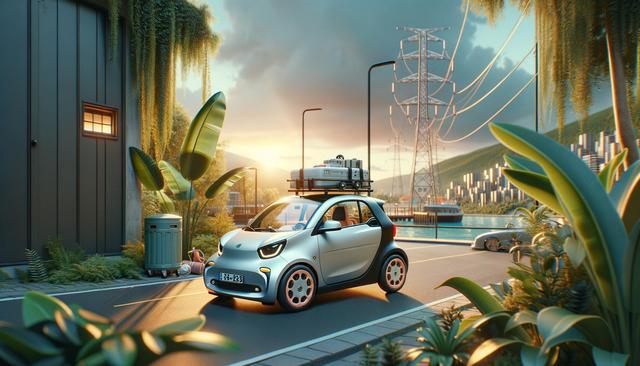Urban Mobility Challenges and the Rise of Compact EVs
As urban populations grow, cities are facing increasing challenges related to transportation, including traffic congestion, limited parking, and rising emissions. Small electric cars offer a practical solution to many of these issues. Their compact size makes them easier to navigate through crowded streets and fit into tight parking spaces, which is a daily struggle for many urban dwellers. These vehicles are also typically lighter, which contributes to improved energy efficiency and lower operating costs compared to larger electric or traditional fuel-powered cars.
In addition to physical convenience, small electric vehicles (EVs) support broader urban planning goals. Many cities are implementing low-emission zones or restricting internal combustion vehicles in central areas. Small EVs align well with these regulations, allowing residents to travel freely while reducing their environmental impact. This has led to increased acceptance and demand in metropolitan regions where sustainability and mobility intersect.
Affordability and Lower Cost of Ownership
One of the key reasons small electric cars are gaining popularity in urban areas is their affordability. While some electric vehicles can be expensive, smaller models tend to come with more accessible price points. This makes them a feasible option for a wider range of consumers, including young professionals, students, and retirees living in the city.
Moreover, the cost benefits extend beyond the purchase price. Small electric cars usually have:
- Lower maintenance costs due to fewer moving parts
- Reduced fuel expenses thanks to electricity being cheaper than gasoline
- Tax incentives or rebates in many regions for choosing electric vehicles
- Access to free or discounted parking and charging in some cities
These factors contribute to a lower total cost of ownership, which is increasingly important as people seek value in their everyday transportation choices.
Efficiency and Performance in City Driving
City driving presents a unique set of demands, such as frequent stops, short distances, and the need for agility in traffic. Small electric cars are particularly well-suited to this environment. Their electric motors provide instant torque, making them responsive and nimble—ideal for navigating through tight streets or merging into busy traffic.
In addition, smaller EVs often have better energy efficiency, meaning they can travel further on a single charge compared to larger electric vehicles. For urban drivers who typically travel short distances, this means fewer charging sessions and more convenience. Charging infrastructure in cities is also expanding, making it easier to maintain battery levels without the need for dedicated home charging stations.
Another advantage is regenerative braking, a feature common in electric vehicles that allows energy to be recovered during braking and fed back into the battery. This not only enhances efficiency but also reduces wear and tear on brake systems, adding to the overall longevity and lower maintenance needs of these vehicles.
Environmental Benefits and Urban Sustainability
Environmental concerns are a driving force behind the shift to electric mobility, and small electric cars are playing a vital role in supporting cleaner, more sustainable cities. These vehicles produce zero tailpipe emissions, which helps reduce local air pollution—a significant issue in densely populated urban areas.
By choosing small EVs, city residents contribute to lower levels of:
- Carbon dioxide (CO2), a major greenhouse gas
- Particulate matter, which affects respiratory health
- Noise pollution, thanks to quieter operation compared to combustion engines
Many municipalities are also integrating electric mobility into public policy and infrastructure development. Investments in charging stations, green zones, and EV-friendly traffic regulations are creating environments where small electric cars can thrive. This not only supports individual drivers but also contributes to broader environmental goals, such as achieving carbon neutrality or improving public health through cleaner air.
Technological Advancements and Consumer Appeal
Technology is another factor accelerating the adoption of small electric cars in urban settings. Modern EVs, even compact ones, come equipped with features that enhance convenience, safety, and connectivity. These include touchscreen infotainment systems, smartphone integration, advanced driver-assistance systems (ADAS), and even autonomous features in some models.
On the battery front, improvements in capacity, charging speed, and durability have made small electric cars more viable than ever before. Urban drivers can now go several days between charges, and with fast-charging options, topping up the battery can take as little as 30 minutes in some cases.
Consumer preferences are also shifting. There is growing awareness of environmental issues and a desire for more responsible consumption. Small EVs cater to this mindset while also offering style and a sense of modernity. As more models become available, consumers have a wider range of choices in terms of design, features, and performance, making these vehicles both practical and appealing.
Conclusion: A Smart Choice for Urban Living
Small electric cars are proving to be a smart and sustainable choice for urban living. They address many of the transportation challenges faced by city dwellers while offering economic and environmental advantages. With growing infrastructure support, advancing technology, and increasing consumer awareness, these compact EVs are carving out a significant role in the future of urban mobility. Whether for commuting, errands, or simply enjoying the flexibility of city driving, small electric vehicles offer a well-rounded solution for those looking to balance convenience with conscious living.




Leave a Reply